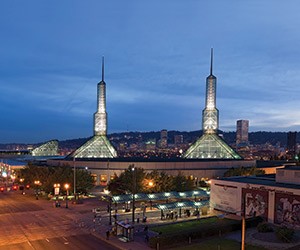Beyond limiting impact on the environment, utilizing a convention center devoted to sustainability makes good business sense.
Thousands of attendees enhance the local community through their presence and the company or association sends a clear message that it’s socially responsible and dedicated to a larger cause than just profits and growth.
“It’s a great opportunity for groups to educate the public about how a meeting designed around sustainability can benefit both the attendees and the city,” says Kevin Wilhelm, CEO of Seattle-based Sustainable Business Consulting and author of the book Return on Sustainability, which examines how climate change impacts companies and how they can improve their financial, brand and sustainability performance.
For planners, the key to any venue evaluation is finding the answers to important questions. In the research process, it’s imperative to wade through the hyperbole and evaluate sustainability on merit, not public relations bluster.
Always Audit
How do you begin the evaluation of a sustainability-focused convention center? Many progressive convention centers now have sustainability coordinators who can guide you to organizations helpful in the evaluation phase.
A starting point in the auditing process is LEED certification (Leadership in Energy and Environmental Design), developed by the U.S. Green Building Council, which incorporates rating systems for design, construction and operation of green buildings.
“Planners need to keep in mind that LEED certification has more to do with bricks and mortar and [is] not directed as much on sustainable behaviors at the facility,” Wilhelm says.
Focused more on operations, the newest sustainability guideline is the APEX/ASTM Environmentally Sustainable Meeting Standards, a partnership between the Convention Industry Council’s Accepted Practices Exchange (APEX) and the American Society for Testing and Materials International (ASTM).
All-encompassing, the standards address nine sectors: accommodations, audiovisual, communications and marketing materials, destinations, exhibits, food and beverage, meeting venue, on-site office and transportation. Additionally, there are eight impact areas targeted: waste, energy, air quality, water, environmental policy, communications, procurement and community partners.
Planners and suppliers can use the guide to help evaluate the numerous sustainability elements.
The Colorado Convention Center in Denver is the first venue to receive certification as a facility that meets APEX/ASTM Environmentally Sustainable Meetings, Events, Trade Shows and Conferences standards.
“The APEX program gives planners another good way to evaluate a sustainable meeting venue and our certification says a lot about our focus on sustainability,” says Lindsay Arell, sustainability programs manager at the Colorado Convention Center.PageBreak
Marketing Matters
Once a sustainable venue is selected, how can planners leverage internal and external marketing efforts?
“More people are paying closer attention to sustainability in their personal lives and attendees are becoming increasingly aware of the ‘green’ components in a meeting,” Arell says. “It helps create enthusiasm for the meeting and morale-building as attendees know they’ll be able to make a contribution, large or small, to sustainability.”
Abby Gulden, sustainability coordinator at the Orange County Convention Center (OCCC), in Orlando says participation by attendees in practices such as recycling or making donations of unused items like t-shirts, tote bags, pens and notepads gives the meeting an added sense of purpose.
Staging a meeting at a sustainable convention center makes a strong statement about a company’s values and commitment to preserving the environment, says Erin Rowland, sustainability coordinator at the Oregon Convention Center in Portland.
At the 2012 Worldwide Convention of 16,000 McDonald’s owner-operators and global staff at the OCCC last April, the company implemented a variety of initiatives to showcase and enhance its green practices to demonstrate to consumers, employees and suppliers its commitment to sustainability.
“We have been in the unique position of developing our sustainability goals in partnership with the OCCC,” says Julie Larson, project manager for McDonald’s’ meetings and events. “As we expand our goals and initiatives, the building staff have been valued partners in helping advance our goals and elevate our efforts to reach new heights.”
Informing the public about the impact of sustainable meetings is evolving.
“There are more opportunities for groups to tout their efforts in social responsibility to the general public,” Gulden says. “At the OCCC, we can now give groups more statistics and metrics on how their sustainable actions measure up and make an impact on the community.”
Walk the Walk
“Talk is cheap when it comes to green practices,” Wilhelm contends. “Planners, suppliers and venues must be able to walk the walk to execute a productive ‘green’ meeting.”
Wilhelm says an acute evaluation of facilities followed by the proper execution of green practices at a meeting makes a positive statement to attendees and the general public.
“Planners should not overlook the importance of the set-up and housekeeping staff, and how adept and experienced they are at executing green practices such as the proper placement of recycling containers and organizing items to be donated,” Rowland says.
Ed Schmidt is a frequent contributor to Meetings Focus and also recycles in his spare time.






